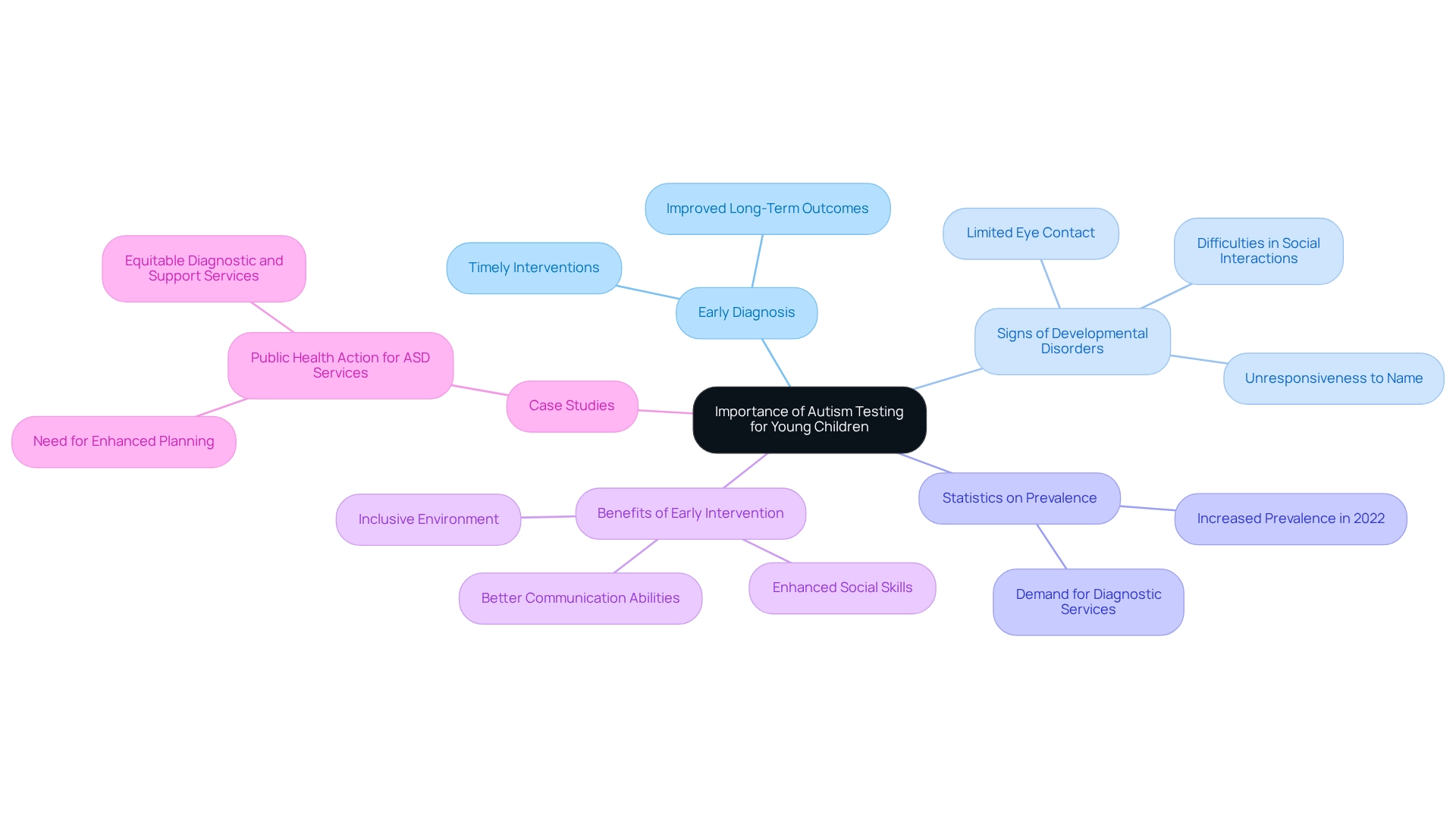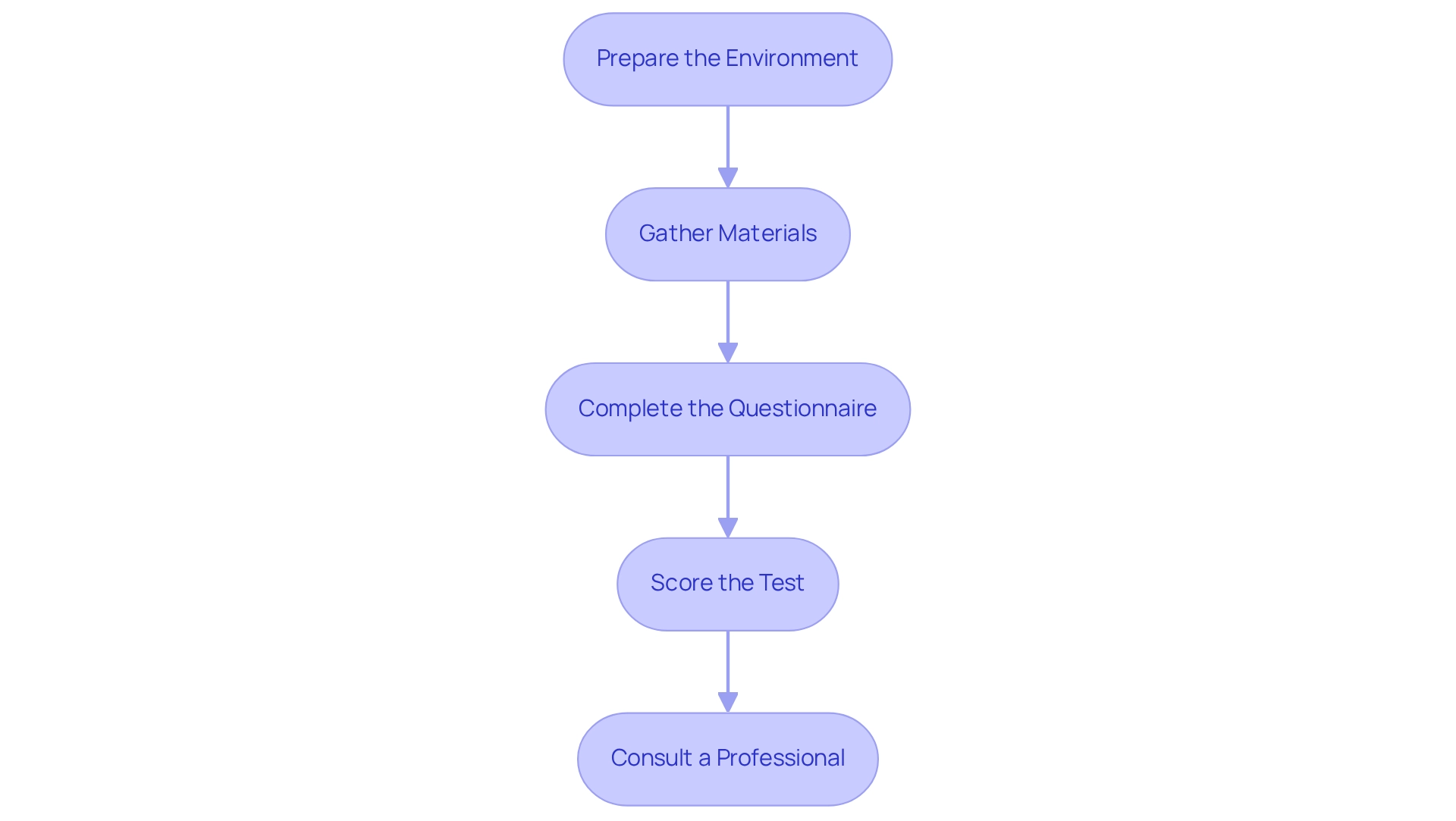Overview
This article highlights four essential steps for administering an autism test for children aged 2 to 3 years, underscoring the critical importance of early diagnosis and intervention. By detailing the testing process—including preparation, administration, and follow-up actions—it aims to provide parents with the insights they need.
Timely evaluations can significantly lead to improved developmental outcomes for children, fostering hope and positive change. We encourage parents to embrace this journey, as understanding and addressing their child's needs early on can make a profound difference.
Introduction
In the journey of parenthood, few challenges can feel as overwhelming as navigating the complexities of autism spectrum disorder (ASD). With autism's prevalence on the rise, understanding the vital role of early testing for children aged 2 to 3 years has never been more important. Early diagnosis can open a world of possibilities, paving the way for timely interventions that significantly enhance a child's social skills and communication abilities. As parents become vigilant observers, recognizing the subtle signs of autism can empower them to seek the necessary evaluations that lead to crucial support. This article explores the importance of autism testing, offering:
- Step-by-step guidance on administering assessments
- Troubleshooting common issues during the process
- Interpreting results to ensure children receive the help they need to flourish.
Understand the Importance of Autism Testing for Young Children
The test de autismo en niños de 2 a 3 años is essential for identifying developmental delays and behavioral challenges at an early stage. Research indicates that early diagnosis can lead to timely interventions, which significantly improve long-term outcomes. Children diagnosed before age 3 often enjoy enhanced social skills, better communication abilities, and overall improved developmental trajectories.
As a parent, it’s important to be attentive to signs of developmental disorders, such as:
- Limited eye contact
- Unresponsiveness to their name
- Difficulties in social interactions
These signs may suggest the need for further assessment. The importance of these evaluations, including the test de autismo en niños de 2 a 3 años, cannot be overstated; they empower parents to take proactive steps in securing support for their children.
Statistics reveal that the prevalence of developmental disorders among children aged 8 years was higher in 2022 than in previous years, underscoring the increasing demand for effective diagnostic and support services. As Amber Grant notes, 'Ongoing rises in prevalence and advancements in early detection of ASD may suggest a growing demand for services.'
Furthermore, case studies demonstrate that early intervention not only benefits the child but also fosters a more inclusive environment, allowing all children with developmental disorders to reach their fullest potential. The findings from the case study titled 'Public Health Action for ASD Services' emphasize the need for better planning to provide equitable diagnostic, treatment, and support services for youth with ASD.
By understanding the significance of developmental assessments, parents can play a crucial role in their child's growth journey.

Follow Step-by-Step Instructions for Administering the Autism Test
Administering a test de autismo en niños de 2 a 3 años, such as the Modified Checklist for Autism in Toddlers (M-CHAT-R), is an important step that requires a systematic approach to ensure accuracy and reliability. By following these steps, you can help support your child's developmental needs.
- Prepare the Environment: Choose a quiet, comfortable area free from distractions. This will help your little one feel secure and at ease.
- Gather Materials: Have the M-CHAT-R questionnaire ready, which includes 20 questions focused on your child's behaviors over the past few months.
- Complete the Questionnaire: Answer each question honestly, reflecting on your recent actions. This honest assessment is crucial for an accurate evaluation.
- Score the Test: After completing the questionnaire, calculate the score using the provided guidelines. A higher score may suggest the need for further evaluation.
- Consult a Professional: If the score raises concerns, it is essential to schedule an appointment with a pediatrician or a youth development specialist for a comprehensive assessment, especially if a test de autismo en niños de 2 a 3 años is warranted for timely diagnosis and intervention.
With 200 citations in Crossref underscoring the importance of early action, it’s clear that taking these steps can lead to better outcomes for your child. Dr. Robins, co-owner of M-CHAT LLC, emphasizes that the M-CHAT-R is a valuable tool for the test de autismo en niños de 2 a 3 años. A risk-benefit analysis of ASD referrals indicates that while reducing the threshold for immediate referrals may lead to excessive evaluations, it is essential to weigh this against the advantages of prompt intervention for those requiring assistance.
It’s also important to note that the study's limitations included its focus on a specific network of pediatric primary care sites in Pennsylvania and New Jersey, which may not represent other populations. By following these steps, you can play a crucial role in the early detection and support of your child's developmental needs.

Troubleshoot Common Issues During the Testing Process
When you’re administering an autism test, you may encounter several common challenges that can feel overwhelming:
- Youngster's Distraction: If your child becomes distracted, try engaging them briefly with a favorite toy or activity. This can help refocus their attention and minimize disruptions, allowing the assessment to flow more smoothly.
- Emotional Responses: If you notice signs of distress or anxiety in your child, it’s important to pause the testing process. Reassuring them and allowing for a break can help them feel comfortable and secure. A calm environment can significantly enhance their ability to participate effectively.
- Inconsistent Responses: Should you observe inconsistencies in your child’s behavior, consider postponing the test for a few weeks. This time can allow for behavioral changes to manifest, leading to a more accurate assessment when you decide to retest.
- Understanding Questions: If certain questions seem unclear, don’t hesitate to refer to the accompanying guidelines for clarification. Consulting a professional can also provide valuable insights, ensuring the test is administered correctly and effectively.
Addressing these concerns in advance can greatly improve the test de autismo en niños de 2 a 3 años, leading to more precise outcomes and better support for your child. It’s crucial to recognize that autistic children are twice as likely to report suicidal thoughts compared to their peers, highlighting the urgent need for accurate assessments and a nurturing testing environment. As Judith Ursitti, co-founder and president of the Profound Autism Alliance, wisely notes, "The continuing recognition of profound autism will open the doors to more inclusive research like the CDC’s. Only then can targeted advocacy enhance access to essential resources and services for this marginalized population." Furthermore, effective support systems, like vocational rehabilitation services, play a vital role in improving outcomes for autistic individuals, underscoring the importance of thorough assessments in facilitating access to necessary resources.
Interpret Test Results and Plan Next Steps for Support
Understanding the outcomes of a developmental assessment is a vital step in supporting your child's growth. It can feel overwhelming, but taking essential actions following the assessment can make a significant difference.
- Review the Score: If the score indicates a potential risk for developmental disorders, seeking further evaluation from a qualified professional is crucial to confirm the findings.
- Consult with Experts: Arrange a follow-up meeting with a pediatrician or a psychologist specializing in developmental disorders. Their expertise will provide a comprehensive assessment and guide you through the next steps.
- Explore Early Intervention Options: Upon receiving a diagnosis, it's important to discuss early intervention strategies such as Applied Behavior Analysis (ABA) therapy, speech therapy, or social skills training. Studies suggest that early intervention can lead to considerable advancements in child development and behavior. Notably, statistics show that 36.5% of autism caregivers utilize ABA therapy, with many reporting positive outcomes, highlighting its importance as an effective treatment option. Additionally, consider the range of methods available, including medication, as 32.8% of youths aged 12-17 received treatment with medication only.
- Join Assistance Groups: Connecting with other parents through support groups can offer invaluable resources and emotional encouragement. Participating in a network of caregivers can help you navigate the complexities of autism therapy and share experiences that promote development and understanding.
The Childhood Autism Rating Scale (CARS) is the most prevalent assessment used for evaluating autism, providing a framework for understanding your child's needs. Furthermore, organizations like Prospera Healthcare offer guidance to parents exploring therapy options, providing tailored therapy plans through the expertise of Board-Certified Behavior Analysts (BCBAs). This personalized support can foster growth and progress for your child. Overall, exploring effective treatment options and consulting specialists is crucial to ensuring the best possible support for your child.
Conclusion
Understanding the significance of autism testing for children aged 2 to 3 years is vital for parents navigating the complexities of autism spectrum disorder. Early diagnosis can lead to timely interventions that dramatically improve a child's social skills, communication abilities, and overall developmental trajectory. By recognizing early signs and administering appropriate assessments, parents can take proactive steps towards securing the necessary support for their children. The increasing prevalence of autism highlights the urgent need for effective diagnostic and support services, making early testing more crucial than ever.
Administering autism tests involves a systematic approach that ensures accuracy and reliability. By preparing the environment, gathering necessary materials, and following a clear set of instructions, parents can effectively evaluate their child's developmental needs. Additionally, troubleshooting common issues during testing—such as distractions or emotional responses—can enhance the experience and lead to more accurate results. It’s essential to approach the testing process with patience and understanding, as a supportive environment can significantly impact a child's performance.
Interpreting test results is a critical step in planning for a child's future support. Seeking consultation with specialists, exploring early intervention options, and joining support groups are all vital actions that can foster a supportive network for both the child and the family. As research continues to show the benefits of early intervention, parents are encouraged to actively engage in their child's developmental journey. By understanding and utilizing the available resources, parents can help their children reach their full potential, ensuring a brighter future for those on the autism spectrum.
Frequently Asked Questions
Why is the autism test for children aged 2 to 3 years important?
The autism test for children aged 2 to 3 years is essential for identifying developmental delays and behavioral challenges early on. Early diagnosis can lead to timely interventions that significantly improve long-term outcomes, including enhanced social skills and better communication abilities.
What signs should parents look for that may indicate a developmental disorder?
Parents should be attentive to signs such as limited eye contact, unresponsiveness to their name, and difficulties in social interactions. These signs may suggest the need for further assessment.
What do statistics indicate about the prevalence of developmental disorders in children?
Statistics reveal that the prevalence of developmental disorders among children aged 8 years was higher in 2022 than in previous years, highlighting an increasing demand for effective diagnostic and support services.
How does early intervention benefit children with developmental disorders?
Early intervention not only benefits the child by improving their developmental trajectory but also fosters a more inclusive environment, allowing all children with developmental disorders to reach their fullest potential.
What is the significance of developmental assessments for parents?
Understanding the significance of developmental assessments empowers parents to take proactive steps in securing support for their children, playing a crucial role in their child's growth journey.




